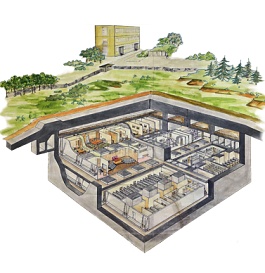
Enthusiasts want to turn the massive "Honecker's bunker" into a museum
 |
The three-story structure with an area of 7,750 m² is known as "Honecker's Bunker," named after the former communist leader Erich Honecker, who had it built for protection in the event of a nuclear war between the Soviet bloc and the West.
Now, as Germans commemorate the 25th anniversary of the fall of the Berlin Wall and the beginning of the end of East Germany, some Berliners are considering transforming this bunker into a museum. Their intent is borne out of nostalgia - or "ostalgia," according to the German word for east - for the communist past.
“When you are inside and know what it was intended for or what they wanted to resist or what they feared, you really understand how serious their fears were,” says Hans Hensel, who is leading the effort to reopen the bunker to the public.
The facility, located about 50 kilometers northeast of Berlin and built for up to 400 members of the political and military leadership of the communist regime, has remained abandoned and closed since the end of the Cold War. Hensel managed to have it opened for a brief three-month period in 2008, attracting around 20,000 curious visitors.
A similar bunker built near Bonn to protect the West German leadership has been open since 2008 and attracts about 80,000 visitors annually.
Hensel is seeking investors to gather the 1.5 million euros (41.5 million crowns) needed to open the museum. He hopes to arrange guided tours, and possibly to open a restaurant and hotel there.
"Honecker's Bunker" was among the most modern facilities of its type in the Soviet bloc. It was constructed between 1978 and 1983 from 85,000 tons of reinforced concrete. It was designed to withstand a chemical attack and manage a megaton nuclear bomb, roughly eighty times more powerful than the bomb dropped on Hiroshima in 1945.
“It is one of the most significant constructions of that time,” says Holger Happel from Berliner Unterwelten, an organization dedicated to researching and documenting historically significant buildings.
“While other Eastern European countries (in the 1980s) were already beginning to slowly change their political systems, the East German government still clung to its communist ideals and spent huge amounts of money on border protection, bunkers, and military facilities,” he adds.
If Western forces had attacked, members of the East German Council of National Defense could have sought refuge in the bunker, first passing through a decontamination chamber where they would be cleansed of any possible radioactive or chemical materials.
They could survive completely independently for two weeks. The bunker would have its own plumbing system, electricity supply, air conditioning, and food supplies. After two weeks, they could assess whether conditions outside were safer and move to a better location in armored vehicles.
Honecker, who died in exile in Chile in 1994, visited this shelter only once. The bunker remained completely secret to most East Germans, even to those who guarded it. “The three hundred soldiers who guarded the area did not know what was inside,” says Hensel. “They knew they were guarding something important, but they didn’t know what.”
A handful of privileged individuals who worked in the bunker were separated from their families, recalls former technical director Juergen Freitag. “For us, it was a very emotional time because we were working in the bunker and knew our families were at home, and if an armed conflict broke out outside, they would be defenseless. It was, of course, a horrible feeling.”
The English translation is powered by AI tool. Switch to Czech to view the original text source.
0 comments
add comment
Related articles
0
27.04.2013 | From Titov's nuclear bunker, a gallery has emerged
0
13.05.2012 | From Hitler's megalomaniacal Germany, only a "sponge" remains in Berlin
2
22.06.2011 | The television series will present historical military fortresses
0
07.11.2010 | Bunker 599 in Diefdijk by Ronald Rietveld
0
02.03.2008 | From the atomic bunker for West German officials, there is a museum
0
28.03.2007 | The super secret repair facility for Russian rockets in the Pilsen region will probably be a hotel
0
21.03.2006 | In Rome, Mussolini's villa will be opened to the public










